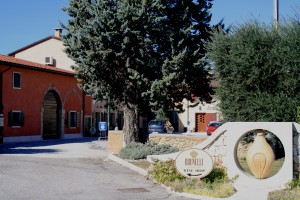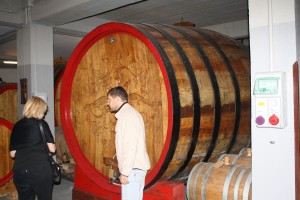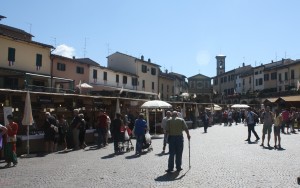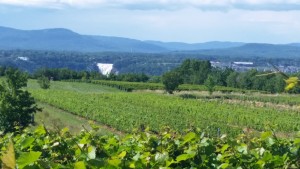We were on vacation in northern Italy and one of our stops was Verona. It’s known for Romeo and Juliet and yes, you can visit that famous balcony and have dinner in Romeo’s house. Verona is a lovely little town that gives visitors a chance to see the Roman, medieval and Renaissance worlds. And it’s about a 20-minute drive from Valpolicella.
A generation or two ago, a lot of wine from Valpolicella was thin, acid and cheap. It was red, hard to pronounce and it paired well with spaghetti and meatballs. Steve’s father, who knew nothing about wine, favored Valpolicella because it’s what Hemingway’s characters drank in the The Sun Also Rises. Little did Dad know that the same region made Amarone, one of Italy’s vinicultural wonders.
Happily, it is easy to tour around the Valpolicella wine growing regions and the wineries welcome visitors. A visit can have its peculiarities, though. We pulled into the courtyard of one winery only to meet the winemaker, who spoke no English. He figured we wanted to taste his wines so he invited us into his house where his daughter, who was studying English in school, poured us some wines at the kitchen table.
At another winery, once again the winemaker spoke no English and he had no daughter to help him. All he could say, at the top of his lungs, was AM-A-RON-E. We drank up, giggled a bit, and went on our way.
If you get off the highway in the village of San Pietro in Cariano, one of the first wineries you’ll see is Brunelli. While not a Napa palace, it will look familiar to American visitors: a little bar, a lot of bottles and someone behind the bar pouring wine. In this fortunate case, the pourer was Alberto Brunelli, winemaker and son of the founder. He took the time to explain what Valpolicella wines are all about, with some excellent tastes to enhance the lecture. Here’s what he said, in capsule form:
The primary grapes are Corvina, Corvinone and Rondinella, unique to the area. The wine pressed at harvest (usually in August) is Valpolicella Classico or Classico Superiore. It’s not at all bad these days, but it’s basically what Steve’s Dad was drinking. The best of the grapes are set on drying racks and left for four months. Of course, they shrivel and the remaining liquid is extremely concentrated. These get pressed and become Amarone which must, by law, be aged in casks for a minimum of three years. The skins are retained and some of the Classico is poured over them to make a Ripasso (re-passed). The second vinification results in a more alcoholic, deep and rounded wine.
 The Brunelli Winery
The Brunelli Winery
At a top-end, rather Napafied winery called Zyme, we tasted a significant number of traditional and not-at-all traditional Valpolicella wines. Our guide that day, seeing that we were truly interested in learning about Valpolicella wines, suggested we call her cousin’s winery to make an appointment for a visit. The next day we asked our hotel to make the call and we drove off. The winery was called Quintarelli Giuseppe; we drove for hours trying to find it. Finally, just before noon, we located it and pulled into their yard. A pleasant young man greeted us and asked what we wanted, as they were closing for lunch. We apologized and said that our hotel had called for an appointment but evidently they never had. Crestfallen, we were about to leave when the nice young man said, “Oh, well, you’re here. I’ll show you around.” And so we got a personal tour and tasting from Francesco Grigoli, winemaker and grandson of the founder. We were treated like family, meeting his mother along the way to the tasting room, where we discovered that we had happened on the premier Valpolicella winery, whose Amarones sell for $350 or more in the US. And what wines! Their Classico is really a Ripasso and their Amarone is, in Steve’s words “a religious experience”.
 Francesco Grigoli showing Lucie the cask
Francesco Grigoli showing Lucie the cask
On the way out, we asked Francesco if he could recommend somewhere for lunch. He said most places were closed that day, but he did know one was open because his mother was dining there that day. He made a call and all we could recognize in the flow of Italian was “due Americani”. He then showed us a little white dot on the horizon and told us to drive there. “How will we find the restaurant?” we asked. “Don’t worry”, he said, “The only things in that village are the church and the restaurant”.
We arrived and were led to a table in the wine cellar. Shortly afterwards, Francesco’s mother arrived with some industry people and greeted us like family. The meal was one of the best we had eaten in Italy and the overall Valpolicella experience was a wine taster’s dream.

